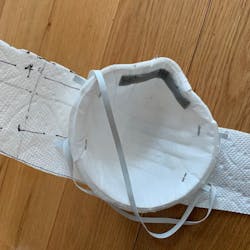Three reasons you should keep sewing face masks (as long as you follow simple best practices)
In the last week, as I’ve worked around the clock with a cross-disciplinary group of designers and academics to develop an effective crowd-sourced DIY face mask, a lot of my smart friends (including a respected epidemiologist in the family) have asked me, “Why are you making homemade face masks if they won’t work.”
This is an important question. Whether you are casually skimming the headlines of recent articles or diving deep into the academic studies, the topline scientific conclusion is pretty clear: Cloth masks do very little to stop the virus. So, yes, we all agree the only real solution is to ramp up production and distribution of N95 masks and other vital PPE’s until they are immediately and ubiquitously available to all health care workers everywhere from the frontline nurse at a major urban hospital to the cleaning staff at a rural clinic… That’s the solution.
But, until we reach that point, DIY masks can have positive impact. Here are three reasons to encourage sewists coast to coast to keep their foot on the pedal (sorry for the pun).
1. Let’s just agree to call it a “cloth N95 protector.” The reality on the ground is many health care workers are being asked to wear their limited supply of N95 masks for an entire shift, sometimes multiple days in a row. A proper DIY face mask pattern follows the “bra cup” shape, which allows it to fit snugly over an N95 mask.
Health care workers are using these to extend the life of their masks in the field. So, if it keeps the online commentators from constantly reminding us that it doesn’t stop a virus, let’s just rebrand it.
2. Leave room for a HEPA filter. A well-designed cloth face mask has some type of wire nose closure and an open pocket to insert something like a HEPA filter. Because this is – still – an emerging crisis, the material most effective to use in these pockets is still murky. But there are experts working on this question now, and DIY’ers should follow this best practice.
3. It may not keep the virus out, but it might keep your sneeze in. While the science is clear the cloth mask is pretty ineffective at stopping airborne particles, there seems to be at least anecdotal evidence that it might help when worn by an infected person. If true, this could be particularly important in a case where many infected don’t know they are infected — including an increasing number of healthcare workers.
So, keep sewing, but try to connect with a community of experts who can advise you on current best practices for mask design; protocols for infection control; and the local healthcare community needs and logistics of delivery.
